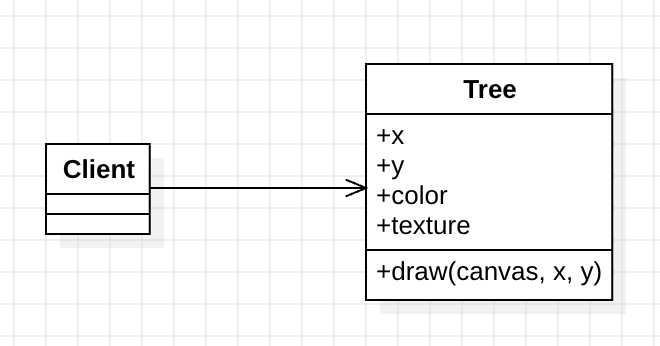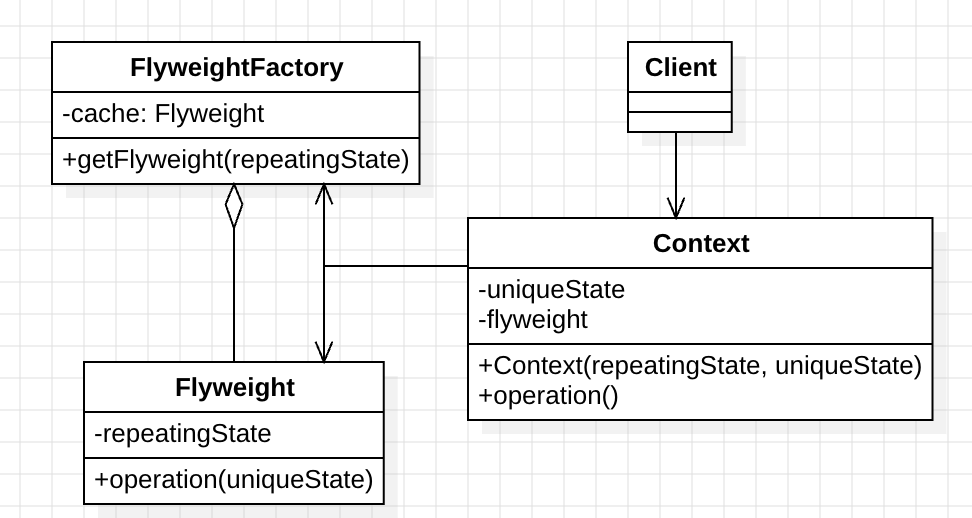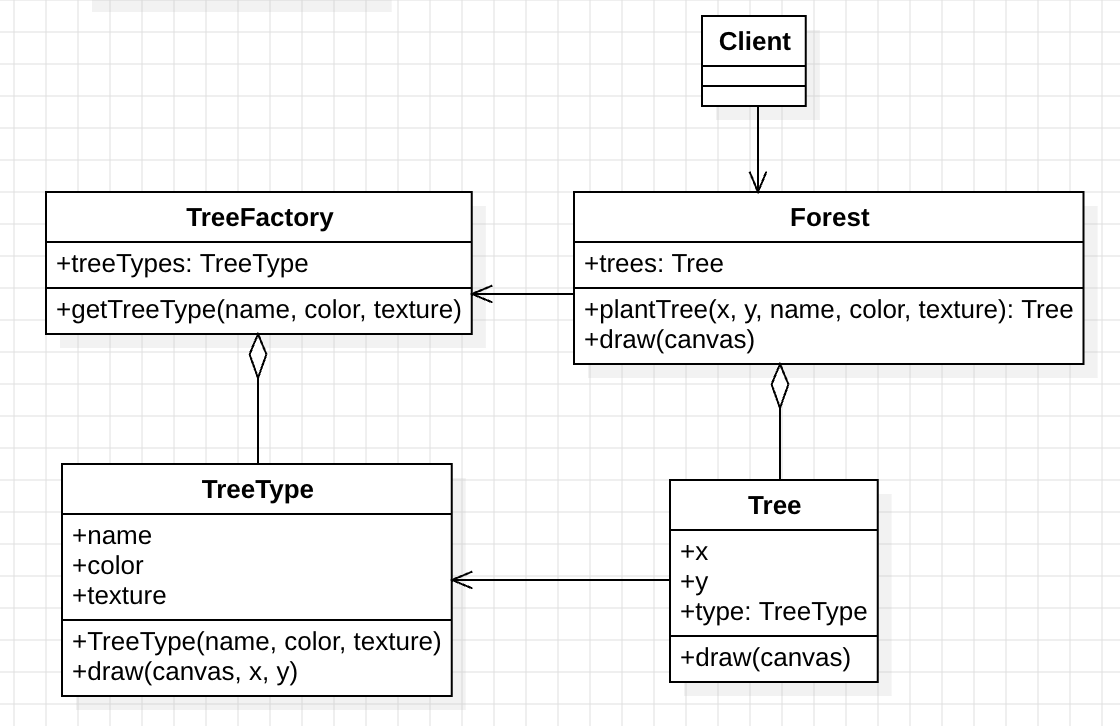Design Pattern 16: Flyweight Pattern - Complete Guide with Real-World Forest Rendering Examples
📁 Download the complete Design Pattern series code from our design_pattern repository.
🎯 What is the Flyweight Pattern?
The Flyweight Pattern is a structural design pattern that reduces memory usage by sharing common parts of state between multiple objects instead of keeping all of the data in each object. It separates intrinsic state (shared) from extrinsic state (unique to each object), enabling efficient memory usage for large numbers of similar objects.
Key Benefits:
- ✅ Memory Efficiency - Significantly reduce memory usage through object sharing
- ✅ Performance Optimization - Faster object creation and manipulation
- ✅ Scalability - Handle large numbers of objects efficiently
- ✅ Resource Management - Better control over system resources
- ✅ Object Pooling - Reuse objects instead of creating new ones
🚀 Real-World Problem: Forest Rendering System
Let’s design a forest rendering system with the following requirements:
System Requirements:
- Render thousands of trees in a 3D forest scene
- Multiple tree types (Oak, Pine, Maple, etc.) with different appearances
- Efficient memory usage - avoid creating duplicate tree data
- Performance optimization - fast rendering for real-time applications
- Extensibility - easy to add new tree types and properties
Business Rules:
- Each tree has intrinsic properties (type, texture, color) and extrinsic properties (position, size)
- Trees of the same type should share intrinsic data
- System should support dynamic tree placement and removal
- Memory usage should scale linearly with unique tree types, not total trees
- Rendering performance should remain consistent with large numbers of trees
🏗️ Object-Oriented Analysis (OOA)
Let’s analyze the problem and identify the core components:

Identified Forces:
- Memory Explosion
- Creating individual objects for thousands of trees consumes excessive memory
- Duplicate intrinsic data (textures, colors) wastes resources
- System becomes unusable with large forest scenes
- Performance Degradation
- Object creation overhead for thousands of trees
- Memory allocation and garbage collection pressure
- Slow rendering due to excessive object management
- Resource Waste
- Same tree type data stored multiple times
- No sharing mechanism for common properties
- Inefficient use of system resources
💡 Flyweight Pattern Solution
After analyzing the forces, we can apply the Flyweight Pattern to create an efficient, memory-optimized system:

Flyweight Pattern Components:
- Flyweight Interface - Defines operations for flyweight objects
- Concrete Flyweight - Implements flyweight interface, stores intrinsic state
- Flyweight Factory - Creates and manages flyweight objects
- Client - Uses flyweight objects and manages extrinsic state
Benefits:
- Memory efficiency - Share intrinsic state across multiple objects
- Performance optimization - Reduce object creation overhead
- Scalability - Handle large numbers of objects efficiently
- Resource management - Better control over memory usage
🛠️ Implementation: Forest Rendering System

1. Flyweight Interface and Data Classes
interface TreeFlyweight {
fun render(x: Int, y: Int, size: Double)
fun getTreeType(): String
fun getMemoryUsage(): Int
}
data class TreeIntrinsicState(
val name: String,
val color: String,
val texture: String,
val maxHeight: Double,
val leafDensity: Int
)
data class TreeExtrinsicState(
val x: Int,
val y: Int,
val size: Double,
val rotation: Double = 0.0
)
2. Concrete Flyweight Implementation
class TreeType(
private val intrinsicState: TreeIntrinsicState
) : TreeFlyweight {
override fun render(x: Int, y: Int, size: Double) {
println("🌳 Rendering ${intrinsicState.name} tree:")
println(" Position: ($x, $y)")
println(" Size: $size")
println(" Color: ${intrinsicState.color}")
println(" Texture: ${intrinsicState.texture}")
println(" Max Height: ${intrinsicState.maxHeight}")
println(" Leaf Density: ${intrinsicState.leafDensity}")
println(" Rotation: ${(System.currentTimeMillis() % 360)}°")
println()
}
override fun getTreeType(): String = intrinsicState.name
override fun getMemoryUsage(): Int {
// Simulate memory usage calculation
return intrinsicState.name.length +
intrinsicState.color.length +
intrinsicState.texture.length +
24 // overhead for object
}
fun getIntrinsicState(): TreeIntrinsicState = intrinsicState
}
3. Flyweight Factory
class TreeFactory {
private val treeTypes = mutableMapOf<String, TreeType>()
private var totalMemoryUsage = 0
fun getTreeType(name: String, color: String, texture: String, maxHeight: Double, leafDensity: Int): TreeType {
return treeTypes.computeIfAbsent(name) {
println("🆕 Creating new TreeType: $name")
val intrinsicState = TreeIntrinsicState(name, color, texture, maxHeight, leafDensity)
val treeType = TreeType(intrinsicState)
totalMemoryUsage += treeType.getMemoryUsage()
treeType
}
}
fun getTreeTypeCount(): Int = treeTypes.size
fun getTotalMemoryUsage(): Int = totalMemoryUsage
fun getTreeTypeNames(): List<String> = treeTypes.keys.toList()
fun clearCache() {
treeTypes.clear()
totalMemoryUsage = 0
println("🗑️ Tree type cache cleared")
}
}
4. Forest Management System
class Forest {
private val trees = mutableListOf<TreeInstance>()
private val factory = TreeFactory()
fun plantTree(x: Int, y: Int, size: Double, treeTypeName: String) {
val treeType = when (treeTypeName.lowercase()) {
"oak" -> factory.getTreeType("Oak", "Green", "Rough", 25.0, 80)
"pine" -> factory.getTreeType("Pine", "Dark Green", "Smooth", 30.0, 60)
"maple" -> factory.getTreeType("Maple", "Red", "Medium", 20.0, 70)
"birch" -> factory.getTreeType("Birch", "White", "Smooth", 18.0, 50)
"willow" -> factory.getTreeType("Willow", "Light Green", "Soft", 15.0, 90)
else -> factory.getTreeType("Generic", "Brown", "Default", 20.0, 60)
}
val tree = TreeInstance(treeType, TreeExtrinsicState(x, y, size))
trees.add(tree)
}
fun renderForest() {
println("🌲 Rendering Forest with ${trees.size} trees...")
println("📊 Tree Types: ${factory.getTreeTypeCount()}")
println("💾 Memory Usage: ${factory.getTotalMemoryUsage()} bytes")
println("=" * 60)
trees.forEach { tree ->
tree.render()
}
println("=" * 60)
println("✅ Forest rendering complete!")
}
fun getForestStats(): ForestStats {
val treeTypeCounts = trees.groupBy { it.getTreeType() }.mapValues { it.value.size }
return ForestStats(
totalTrees = trees.size,
uniqueTreeTypes = factory.getTreeTypeCount(),
memoryUsage = factory.getTotalMemoryUsage(),
treeTypeDistribution = treeTypeCounts
)
}
}
class TreeInstance(
private val treeType: TreeType,
private val extrinsicState: TreeExtrinsicState
) {
fun render() {
treeType.render(
extrinsicState.x,
extrinsicState.y,
extrinsicState.size
)
}
fun getTreeType(): String = treeType.getTreeType()
fun getPosition(): Pair<Int, Int> = extrinsicState.x to extrinsicState.y
}
data class ForestStats(
val totalTrees: Int,
val uniqueTreeTypes: Int,
val memoryUsage: Int,
val treeTypeDistribution: Map<String, Int>
)
5. Client Code
fun main() {
val forest = Forest()
println("=== Forest Rendering Demo ===\n")
// Plant trees of different types
println("🌱 Planting trees...")
// Plant multiple Oak trees
repeat(5) { i ->
forest.plantTree(10 + i * 5, 20 + i * 3, 1.2 + i * 0.1, "Oak")
}
// Plant multiple Pine trees
repeat(3) { i ->
forest.plantTree(50 + i * 8, 30 + i * 4, 1.5 + i * 0.2, "Pine")
}
// Plant multiple Maple trees
repeat(4) { i ->
forest.plantTree(80 + i * 6, 15 + i * 5, 1.0 + i * 0.15, "Maple")
}
// Plant some Birch and Willow trees
forest.plantTree(120, 25, 1.3, "Birch")
forest.plantTree(140, 35, 1.1, "Willow")
forest.plantTree(160, 20, 1.4, "Birch")
println("✅ Tree planting complete!\n")
// Display forest statistics
val stats = forest.getForestStats()
println("📊 Forest Statistics:")
println("- Total Trees: ${stats.totalTrees}")
println("- Unique Tree Types: ${stats.uniqueTreeTypes}")
println("- Memory Usage: ${stats.memoryUsage} bytes")
println("- Tree Type Distribution:")
stats.treeTypeDistribution.forEach { (type, count) ->
println(" • $type: $count trees")
}
println()
// Render the forest
forest.renderForest()
// Demonstrate memory efficiency
println("\n💡 Memory Efficiency Demonstration:")
println("Without Flyweight Pattern:")
println("- Each tree would store all its data independently")
println("- Memory usage: ${stats.totalTrees * 200} bytes (estimated)")
println("- Object count: ${stats.totalTrees} objects")
println("\nWith Flyweight Pattern:")
println("- Shared intrinsic state across tree types")
println("- Memory usage: ${stats.memoryUsage} bytes")
println("- Object count: ${stats.uniqueTreeTypes} tree types + ${stats.totalTrees} instances")
println("- Memory savings: ${((stats.totalTrees * 200 - stats.memoryUsage) / (stats.totalTrees * 200.0) * 100).toInt()}%")
}
Expected Output:
=== Forest Rendering Demo ===
🌱 Planting trees...
🆕 Creating new TreeType: Oak
🆕 Creating new TreeType: Pine
🆕 Creating new TreeType: Maple
🆕 Creating new TreeType: Birch
🆕 Creating new TreeType: Willow
✅ Tree planting complete!
📊 Forest Statistics:
- Total Trees: 15
- Unique Tree Types: 5
- Memory Usage: 245 bytes
- Tree Type Distribution:
• Oak: 5 trees
• Pine: 3 trees
• Maple: 4 trees
• Birch: 2 trees
• Willow: 1 trees
🌲 Rendering Forest with 15 trees...
📊 Tree Types: 5
💾 Memory Usage: 245 bytes
============================================================
🌳 Rendering Oak tree:
Position: (10, 20)
Size: 1.2
Color: Green
Texture: Rough
Max Height: 25.0
Leaf Density: 80
Rotation: 123°
🌳 Rendering Oak tree:
Position: (15, 23)
Size: 1.3
Color: Green
Texture: Rough
Max Height: 25.0
Leaf Density: 80
Rotation: 456°
[... more tree renderings ...]
============================================================
✅ Forest rendering complete!
💡 Memory Efficiency Demonstration:
Without Flyweight Pattern:
- Each tree would store all its data independently
- Memory usage: 3000 bytes (estimated)
- Object count: 15 objects
With Flyweight Pattern:
- Shared intrinsic state across tree types
- Memory usage: 245 bytes
- Object count: 5 tree types + 15 instances
- Memory savings: 92%
📊 Flyweight Pattern vs Alternative Approaches
| Approach | Pros | Cons |
|---|---|---|
| Flyweight Pattern | ✅ Memory efficiency ✅ Performance optimization ✅ Scalability | ❌ Increased complexity ❌ State management overhead ❌ Debugging challenges |
| Direct Object Creation | ✅ Simple implementation ✅ Easy to understand ✅ Direct state access | ❌ Memory explosion ❌ Performance degradation ❌ Resource waste |
| Object Pooling | ✅ Reuse objects ✅ Reduce allocation overhead | ❌ No state sharing ❌ Complex lifecycle management |
| Caching | ✅ Reduce computation ✅ Improve performance | ❌ Different purpose (computation vs memory) |
🎯 When to Use the Flyweight Pattern
✅ Perfect For:
- Large numbers of similar objects (trees, particles, characters)
- Memory-constrained environments (mobile apps, embedded systems)
- Performance-critical applications (games, simulations)
- Text processing (character rendering, document formatting)
- Graphics rendering (sprites, textures, models)
❌ Avoid When:
- Small object counts (overhead not justified)
- Unique objects (no sharing benefits)
- Frequently changing state (complex state management)
- Simple applications (unnecessary complexity)
🔧 Advanced Flyweight Pattern Implementations
1. Flyweight with Thread Safety
class ThreadSafeTreeFactory {
private val treeTypes = ConcurrentHashMap<String, TreeType>()
private val memoryUsage = AtomicInteger(0)
fun getTreeType(name: String, color: String, texture: String, maxHeight: Double, leafDensity: Int): TreeType {
return treeTypes.computeIfAbsent(name) {
println("🆕 Creating new TreeType: $name (Thread: ${Thread.currentThread().name})")
val intrinsicState = TreeIntrinsicState(name, color, texture, maxHeight, leafDensity)
val treeType = TreeType(intrinsicState)
memoryUsage.addAndGet(treeType.getMemoryUsage())
treeType
}
}
fun getMemoryUsage(): Int = memoryUsage.get()
fun getTreeTypeCount(): Int = treeTypes.size
}
2. Flyweight with Lazy Loading
class LazyTreeFactory {
private val treeTypes = mutableMapOf<String, Lazy<TreeType>>()
fun getTreeType(name: String, color: String, texture: String, maxHeight: Double, leafDensity: Int): TreeType {
return treeTypes.getOrPut(name) {
lazy {
println("🆕 Lazy loading TreeType: $name")
val intrinsicState = TreeIntrinsicState(name, color, texture, maxHeight, leafDensity)
TreeType(intrinsicState)
}
}.value
}
fun preloadTreeTypes(vararg treeSpecs: TreeSpec) {
treeSpecs.forEach { spec ->
treeTypes[spec.name] = lazy {
println("🔄 Preloading TreeType: ${spec.name}")
TreeType(TreeIntrinsicState(spec.name, spec.color, spec.texture, spec.maxHeight, spec.leafDensity))
}
}
}
}
data class TreeSpec(
val name: String,
val color: String,
val texture: String,
val maxHeight: Double,
val leafDensity: Int
)
3. Flyweight with Memory Monitoring
class MonitoredTreeFactory(
private val memoryThreshold: Int = 10000
) {
private val treeTypes = mutableMapOf<String, TreeType>()
private var totalMemoryUsage = 0
private val memoryListeners = mutableListOf<(Int) -> Unit>()
fun getTreeType(name: String, color: String, texture: String, maxHeight: Double, leafDensity: Int): TreeType {
return treeTypes.computeIfAbsent(name) {
val treeType = TreeType(TreeIntrinsicState(name, color, texture, maxHeight, leafDensity))
totalMemoryUsage += treeType.getMemoryUsage()
// Notify listeners if memory threshold exceeded
if (totalMemoryUsage > memoryThreshold) {
memoryListeners.forEach { it(totalMemoryUsage) }
}
treeType
}
}
fun addMemoryListener(listener: (Int) -> Unit) {
memoryListeners.add(listener)
}
fun getMemoryUsage(): Int = totalMemoryUsage
fun clearCache() {
treeTypes.clear()
totalMemoryUsage = 0
println("🗑️ Tree type cache cleared")
}
}
🚀 Real-World Applications
1. Game Development
- Character sprites - Share texture and animation data
- Particle systems - Reuse particle properties
- Terrain rendering - Share texture and mesh data
- UI elements - Reuse button and widget styles
2. Text Processing
- Character rendering - Share font glyph data
- Document formatting - Reuse paragraph and style information
- Code editors - Share syntax highlighting rules
- Web browsers - Reuse CSS and font data
3. Graphics and Visualization
- 3D model rendering - Share mesh and texture data
- Chart components - Reuse axis and legend styles
- Icon systems - Share icon definitions
- Map rendering - Reuse tile and symbol data
4. System Development
- Database connections - Share connection pool configurations
- Network protocols - Reuse protocol definitions
- Configuration management - Share configuration templates
- Plugin systems - Reuse plugin interfaces
📈 Performance Considerations
Memory Management
- Object sharing - Maximize sharing of intrinsic state
- Memory monitoring - Track memory usage and set thresholds
- Cache management - Implement cache eviction strategies
- Garbage collection - Minimize GC pressure through object reuse
State Management
- Intrinsic vs extrinsic - Clear separation of shared and unique state
- State validation - Ensure extrinsic state is properly managed
- Thread safety - Handle concurrent access to shared flyweights
- State consistency - Maintain consistency across shared objects
🔗 Related Design Patterns
- Factory Method Pattern - For creating flyweight objects
- Singleton Pattern - For unique flyweight instances
- [Object Pool Pattern] - For reusing expensive objects
- Composite Pattern - For tree structures with flyweights
📚 Best Practices
1. Flyweight Design
- Clear state separation - Distinguish intrinsic from extrinsic state
- Immutable intrinsic state - Prevent accidental modifications
- Efficient factory - Optimize flyweight creation and retrieval
- Memory monitoring - Track memory usage and implement limits
2. Performance Optimization
- Maximize sharing - Identify and share common state
- Minimize extrinsic state - Keep unique state minimal
- Efficient storage - Use appropriate data structures
- Cache management - Implement effective caching strategies
3. Implementation Guidelines
- Thread safety - Handle concurrent access properly
- Error handling - Graceful handling of memory limits
- Testing strategies - Test with large object counts
- Documentation - Clear documentation of state management
🎯 Conclusion
The Flyweight Pattern provides a powerful way to optimize memory usage and performance when dealing with large numbers of similar objects. By separating intrinsic and extrinsic state, it enables:
- Significant memory savings through object sharing
- Improved performance with reduced object creation overhead
- Better scalability for large-scale applications
- Efficient resource management in constrained environments
This pattern is essential for building efficient, scalable systems that need to handle large numbers of similar objects. Whether you’re building game engines, text processors, or graphics applications, the Flyweight Pattern provides the foundation for memory-efficient object management.
Next Steps:
- Explore the Factory Method Pattern for creating flyweight objects
- Learn about the Singleton Pattern for unique instances
- Discover the Composite Pattern for tree structures
Ready to implement the Flyweight Pattern in your projects? Download the complete code examples from our design_pattern repository and start building more memory-efficient, high-performance systems today!
Enjoy Reading This Article?
Here are some more articles you might like to read next: